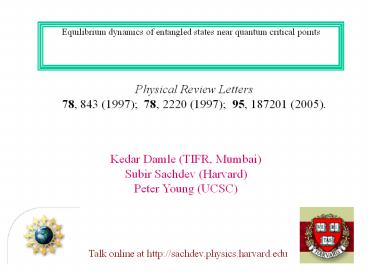Equilibrium dynamics of entangled states near quantum critical points - PowerPoint PPT Presentation
Title:
Equilibrium dynamics of entangled states near quantum critical points
Description:
Equilibrium dynamics of entangled states near quantum critical points ... Important property of ground state at g=gc : temporal and spatial scale ... – PowerPoint PPT presentation
Number of Views:118
Avg rating:3.0/5.0
Title: Equilibrium dynamics of entangled states near quantum critical points
1
Equilibrium dynamics of entangled states near
quantum critical points
Physical Review Letters 78, 843 (1997) 78,
2220 (1997) 95, 187201 (2005).
Kedar Damle (TIFR, Mumbai)
Subir Sachdev (Harvard)
Peter Young (UCSC)
Talk online at http//sachdev.physics.harvard.edu
2
Why study quantum phase transitions ?
gc
g
- Critical point is (often) a novel (entangled)
state of matter without quasiparticle excitations
- Critical excitations control dynamics in the
wide quantum-critical region at non-zero
temperatures.
3
I. Quantum Ising Chain
4
(No Transcript)
5
Experimental realization
LiHoF4
6
Weakly-coupled qubits
Ground state
7
Weakly-coupled qubits
Quasiparticle pole
Three quasiparticle continuum
3D
Structure holds to all orders in 1/g
8
Quantum mechanical S-matrix has a universal
form at low momenta (in one
dimension)
(-1)
9
(No Transcript)
10
(No Transcript)
11
(No Transcript)
12
Strongly-coupled qubits
Ground states
13
Strongly-coupled qubits
Two domain-wall continuum
2D
Structure holds to all orders in g
14
(No Transcript)
15
(No Transcript)
16
(No Transcript)
17
Entangled states at g of order unity
18
Critical coupling
No quasiparticles --- dissipative critical
continuum
19
S. Sachdev and J. Ye, Phys. Rev. Lett. 69, 2411
(1992). S. Sachdev and A.P. Young, Phys. Rev.
Lett. 78, 2220 (1997).
20
II. Quantum O(3) non-linear s model
21
Quantum mechanical S-matrix has a universal
form at low momenta (in one
dimension)
(-1)
22
t
x
23
(x,t)
t
(0,0)
x
24
(No Transcript)
25
III. Quantum sine-Gordon model
26
Quantum mechanical S-matrix has a universal
form at low momenta (in one
dimension)
(-1)
27
(No Transcript)
28
(No Transcript)
29
III. Quantum sine-Gordon model
30
Conclusions
- Large, entangled quantum systems close to
equilibrium have an intrinsic relaxation rate
independent of the strength of the coupling to a
heat bath. - This relaxation rate has a universal form near
interacting quantum critical points - In one-dimensional systems































